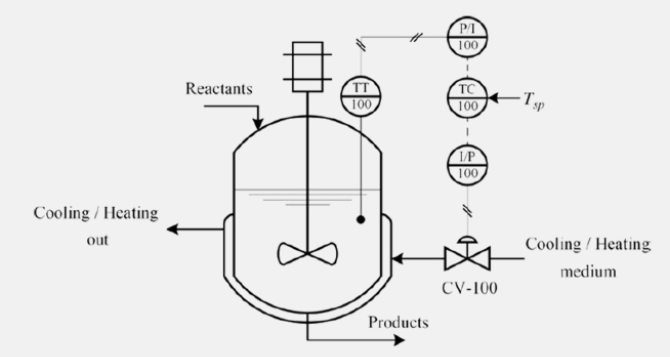Question
The figure below shows an upset tank in which a process stream is cooled by circulating cooling water through the jacket. The input variables of
The figure below shows an upset tank in which a process stream is cooled by circulating cooling water through the jacket. The input variables of this process are the cooling water flow, fc(t) and the reactant feed flow, f(t). The output variables of interest are the process and cooling water outlet temperatures, T(t) and Tc(T), respectively.

- Considering a negligible enthalpy of reaction, deduce the transfer functions of the process:
 - Considering water as coolant with a volume of 1 m3, and initial temperature of 18 C and inside the reactor a solution volume of 2.08 m3, density of 19.2 kgmol/m3, Cp=2815 J/(kgmol C) and initial temperature 65C Determines the global behavior of the reactor temperature and the coolant temperature at a reactant flow input of 350 L/min and a cooling water flow of 20 L/min when the global heat transfer coefficient is 4,589 J. /(m2 C min) with a heat exchange area of 3 m2. Consider the temperature inside the reactor at equilibrium of 33C and the coolant temperature at equilibrium of 15.5C. - What is the stabilization time of the process outlet temperatures and of the cooling water, T(t) and the final stabilization value Tc(T) before the inlet flows considered in the previous point? - Deduce numerically the value of the damping factor and natural frequency of the second order system. - How is the temperature of the reactor modified if the enthalpy of reaction is not negligible in the thermodynamics of the process? Argue your answer by analyzing the expressions for the roots of the characteristic polynomial.
- Considering water as coolant with a volume of 1 m3, and initial temperature of 18 C and inside the reactor a solution volume of 2.08 m3, density of 19.2 kgmol/m3, Cp=2815 J/(kgmol C) and initial temperature 65C Determines the global behavior of the reactor temperature and the coolant temperature at a reactant flow input of 350 L/min and a cooling water flow of 20 L/min when the global heat transfer coefficient is 4,589 J. /(m2 C min) with a heat exchange area of 3 m2. Consider the temperature inside the reactor at equilibrium of 33C and the coolant temperature at equilibrium of 15.5C. - What is the stabilization time of the process outlet temperatures and of the cooling water, T(t) and the final stabilization value Tc(T) before the inlet flows considered in the previous point? - Deduce numerically the value of the damping factor and natural frequency of the second order system. - How is the temperature of the reactor modified if the enthalpy of reaction is not negligible in the thermodynamics of the process? Argue your answer by analyzing the expressions for the roots of the characteristic polynomial.
Step by Step Solution
There are 3 Steps involved in it
Step: 1

Get Instant Access to Expert-Tailored Solutions
See step-by-step solutions with expert insights and AI powered tools for academic success
Step: 2

Step: 3

Ace Your Homework with AI
Get the answers you need in no time with our AI-driven, step-by-step assistance
Get Started


